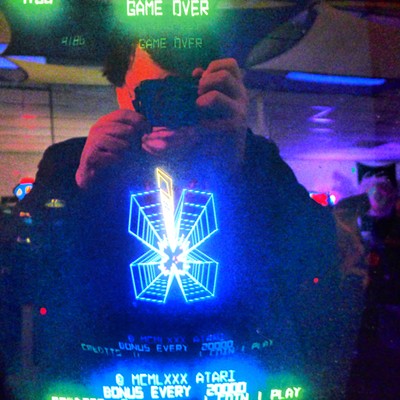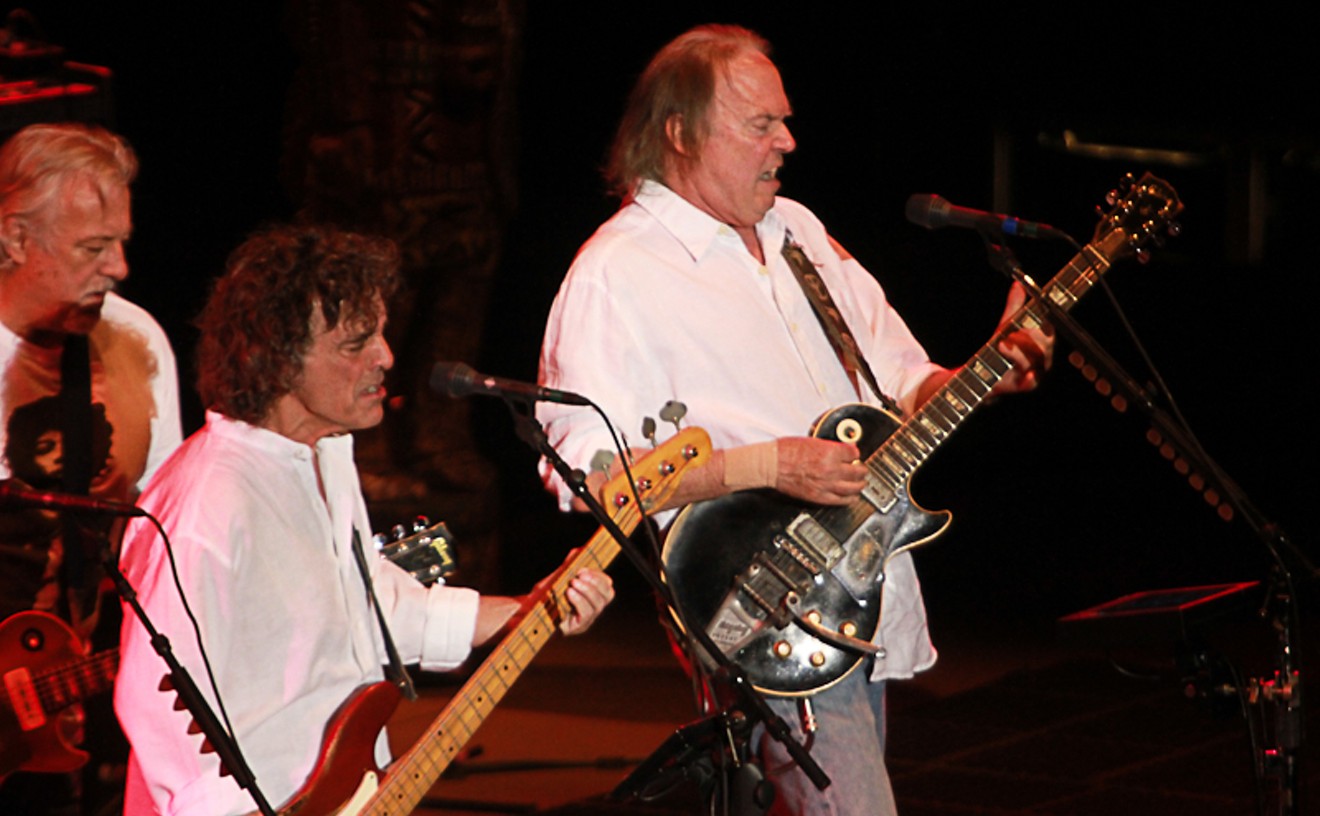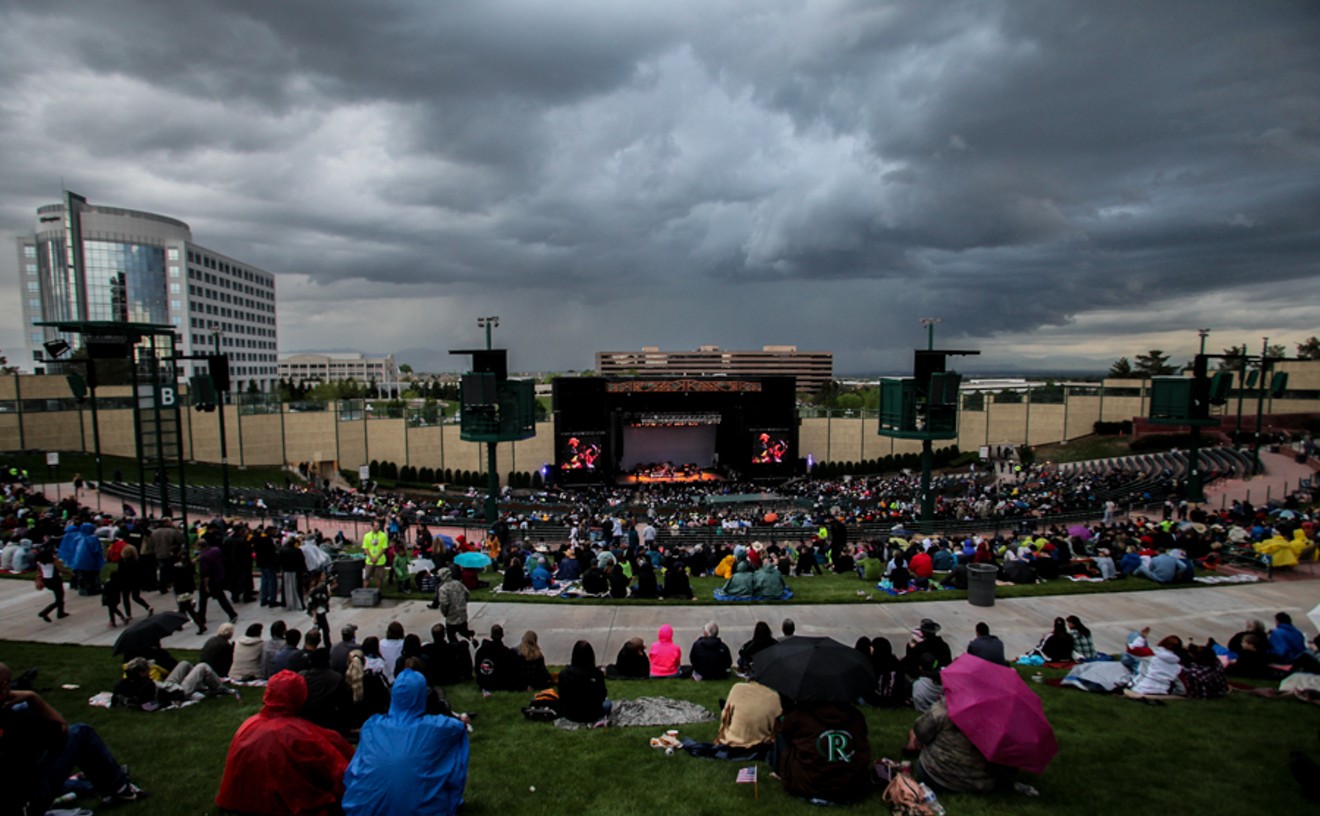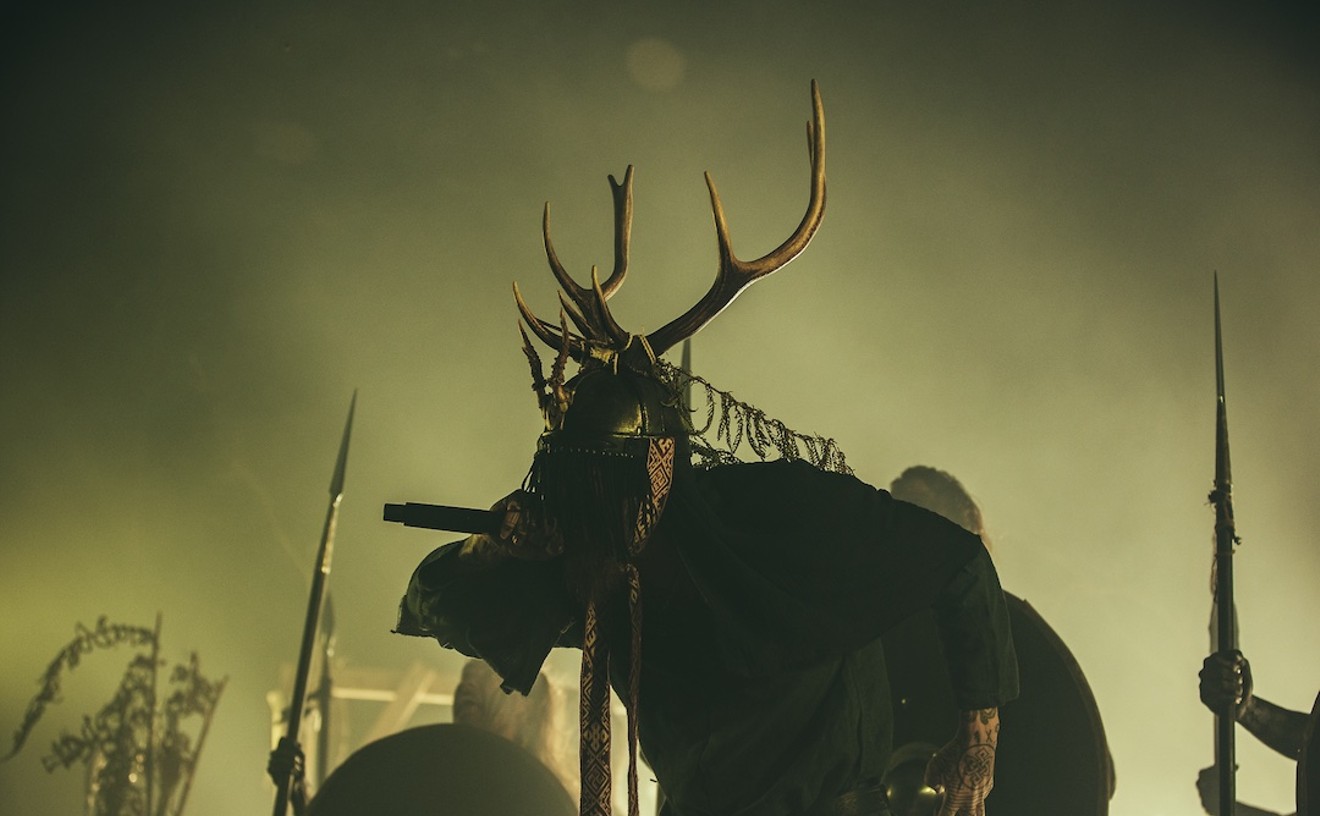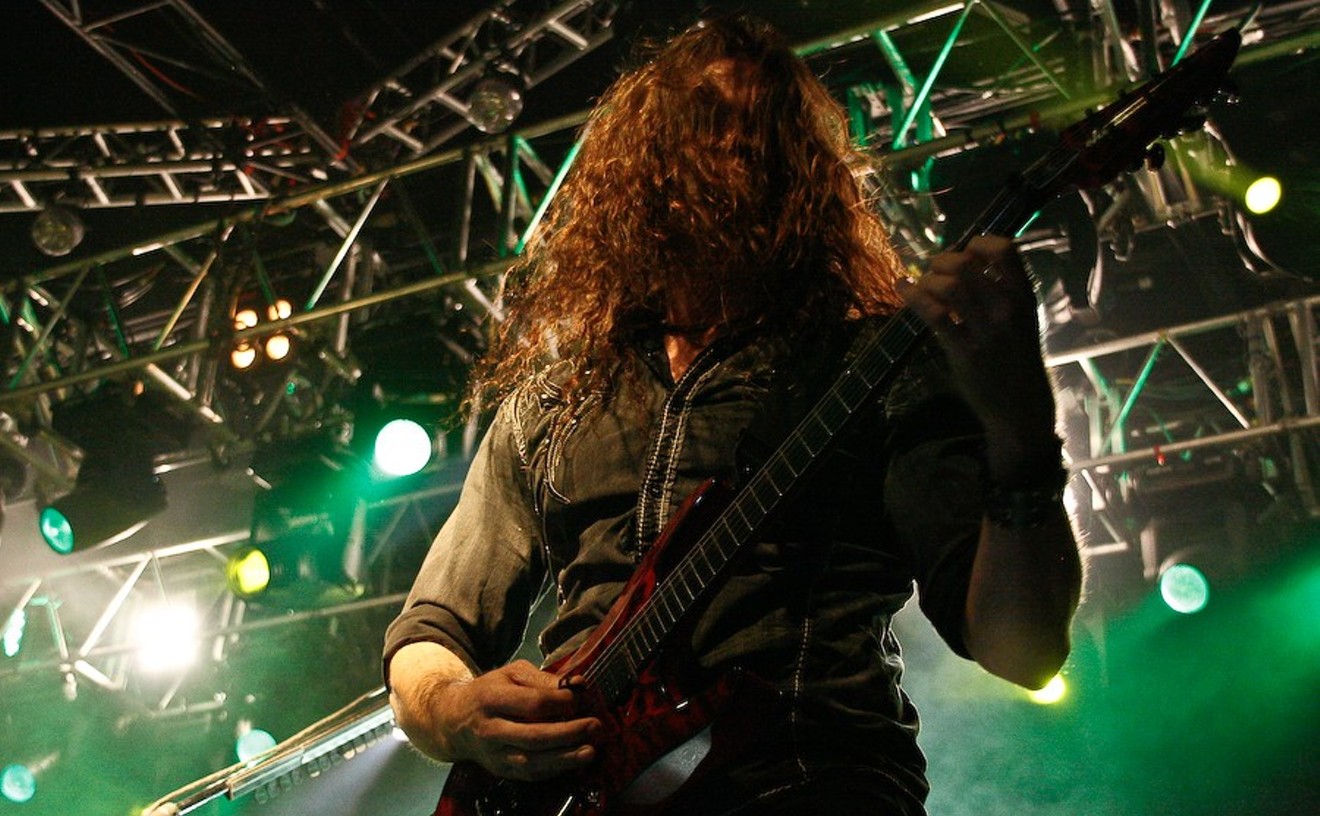In 1986, 40th Day, reconvening for a show this weekend at the Larimer Lounge, came together when drummer Sid Davis and then guitarist Todd Howell formed the project in the D.U. area, where many of the band members over the years lived. That's also where the band's practice space was located, a place called the Greenhaus, a name which doubled as the name of imprint established by Davis' brother to independently release the outfit's albums.
See also: - Saturday: 40th Day at Larimer Lounge, 7/20/13 - I'm a Boy has a long local history - Q&A with Tammy Ealom of Dressy Bessy
A couple of years after forming, 40th Day released its first record, Something Hidden Here, which reflected Howell's taste in sounds with jangly guitar, clean tones and almost folk-oriented song structures with atmospheric melodies. At that point, the outfit's lineup was rounded out by bass player Jimmi Nasi, keyboardist Mindy Uhrlaub and singer Shawn Strub, who replaced the band's earlier, charismatic singer Jenny Scorcz.
With Strub's classical training and naturally powerful voice, she brought a different sensibility to the band, one that lent itself well to the next phase of the band's songwriting. Howell left the band before the turn of the decade and Nasi's Screaming Locusts on Diving Boards bandmate, Neil Satterfield, came in with a completely different sonic palette.
The music went in a direction more with the times in the era of nascent, alternative rock, best represented on 1992's Lovely Like a Snake, an album filled with driving, dynamic rock, haunting atmospherics, interweaving melodies, industrial beats and thought-provoking lyrics. In an era in Denver music made up of not-well-enough remembered luminaries of non-mainstream rock like Twice Wilted, Jux County, Baldo Rex and Sympathy F, 40th Day stood in good stead with its peers.
But 1993 brought many changes, and Strub left the band for a solo career that didn't take off as abundantly as it should have. The remaining band members ended up recruiting Tammy Ealom who, though a solid and charismatic performer, had tastes that ran more toward the angular pop and psychedelia of the 1990s, and the 40th Day passed into history by the middle of the decade with the members of the band dispersing to different parts of the country and even, in the case of Davis, the world.
If you talked to anyone who got to see the band, they'd have nothing but words of praise for one of Denver's finest. Lovely Like a Snake, a true classic from Denver's early alt rock era, can now be found at Wax Trax and Twist and Shout, thanks to some sealed copy of the CD that some friends of the band unearthed in recent years. There are rumors of unreleased material coming out at a later date to reflect the later periods of 40th Day's songwriting.
Tomorrow night, the group is reconvening, with Tony Morales, a longtime friend from Sympathy F filling in for Davis. In advance of the act's highly anticipated reunion show, we spoke with Nasi, Strub and Uhrlaub about Lovely Like a Snake.
Westword: The sound of the earlier period of 40th Day as represented on Something Hidden Here was very different from the songs you wrote for Lovely Like A Snake, even within a year or two of the release of that first album. What was the catalyst for that switch?
Shawn Strub: It definitely had something to do with changing guitar players.
Jimmi Nasi: Well, it started with getting Mindy [Wuhrlaub], and that was the first step of going toward what Sid [Davis] was into at that time. Todd [Howell] wasn't all that hip on it, but he was cool because he knew Sid really wanted it.
Mindy Uhrlaub: I feel like with the keyboards in the band you had this percussive instrument that wasn't just drums. And then a noisy instrument that wasn't a guitar. But it was weird because I remember initially joining the band and not knowing where I belonged, and really taking cues from everybody else.
Really quickly, after Todd left, it changed, and it changed again once Bryon [Bean] and Tammy [Ealom] joined the band. It became a different thing. So I knew at least the keyboards became more influential in the music. But I think also Neil [Satterfield's playing changed the sound]. I always thought of Todd as being this sort of jangle-y, kind of cowboy rock kind of guy.
SS: Atmospheric folk. Neil is dark and epic, a huge sound. Expansive.
JN: It's interesting because he used the same amp, [a Roland JC-120] as Todd, and the same delay pedal as Todd. But he had a Strat, and he's a metal guy, just like me. Todd is not a metal guy. So it got more sonic. Way more riffs. Todd was not a riffs guy.
MW: He was a chords guy.
JN: Todd played arpeggios and was very orchestrated. Neil was very much a play some cool hook down here and then some wacked out crazy stuff in the solo.
SS:I feel like we started building a lot of dynamics at that point, too, where the songs would drop out and there would be a huge, big epic part at the end.
Like on "End of a Day" where there's a big sound that drops out and builds back up?
Shawn: Yeah. And it would be these waves, and they would come down, and that, for me, defines the sound while I was in the band.
JN: Sid had always been going to see industrial music and stuff like that, and we were into that stuff, as well. But then there were these bands like Jane's Addiction that came out, and we're hearing this mix of alternative, atmospheric, underground music and heavy metal and arena music.
So it was, "Oh you can have heavy guitars, you can have anthemic, big, heavy metal stuff and still have melody, atmosphere and weirdness. It was almost like punk rock and heavy metal, and look at what you can do in music that's not just notes, not just chords and not just a great song, but something that's greater than the sum of its parts, like there's a sixth sound happening, the sixth member of the band.
There's a bunch of parts on Lovely Like a Snake where the effects, whether it's on one instrument or the effect of everyone playing together and going through some kind of reverb onto tape.
SS: It becomes this ghost-y part. Something you can never put down but it's actually in the song.
MW: But it happens when we play live, too, and that's what kills me. Your brother said it, [Jimmi], when he was [at practice this time around]. He said, "You guys actually listen to each other." The thing is that at any given time we have melody. We're all really melodic players and when you put it all together it's a strange mix that doesn't usually oppose.
JN: It's really cool because everybody's just doing what they want to do. That all stems from our songwriting process which was a groove starts, everybody plays and we don't ask, we don't tell.
SS: It was very stream-of-consciousness. Then after we had the cell of an idea we would arrange it or you and Sid would arrange it.
JN: We did come up with stuff, and we would talk through it, and do a little chopping up.
Like spontaneous composition?
JN: Yes, and improv-based spontaneous composition.
SS: The term "Instasong" came from the fact that song happened out of nowhere.
MW: The first title for that song was "The Snap-Together Song." I have it on a cassette tape, and the title has an X through, and it says "Instasong." It was like Legos--stick these things together and see what happens.
SS: It was the magical thing of everybody, and what we contributed that fit together that made everything unique. It happened with each of the different line-ups creating a totally different sound.
MW: I think about it a lot. Why aren't there more vocals on "East Of The Sun" or "Angel One," and it's because sometimes the best song you can make as a musician is no sound at all. She's got this huge voice, and there were times when she would step back so this other sound could ring through. And there are other parts where a certain instrument dropped out for several measures, and it just made it more powerful when the musician came back in. I felt like we had these crazy, intersecting melodies, so that when one person would back out it would be more powerful at times. I'm sure all bands say that at some point.
JN: You know, because you can't have everyone playing all the time. Sid was very passionate about making sure that things were changing and textures were changing. It's the art aspect, too. We were all artists, so we weren't just making a rock and roll tune. Shawn plays in a duo now, and I play in a trio, and I love it, but the 40th Day was so different because it was five people going on at the same time, and it was very big. It was a democracy, which is rare in life, in general, and extremely rare in music.
At some point a title suggested itself to you.
JN: That was me. It was a stream-of-consciousness rant on my part. This hip-hop guy had seen 40th Day. He was a rapper that Sid and I would see at Panic Bar at 23 Parish, which was the hip-hop night at 23 Parish. He was like, "Man, the music was lovely, man, lovely." I just loved the way that sounded. He asked how I would describe the music, and I was running my mouth. A friend called it "Drunk driving over everybody with your mouth."
MW: I loved Captain Decibel the best.
JN: I got that name because I'm loud. I would like to thank you ladies for all your patience over the years.
"End of a Day" is one of your most iconic songs.
JN: Neil told me yesterday that "End of a Day" is something he came up with in his apartment in Hollywood. That guitar progression -- that slicing rhythm thing.
MW: I like the lyrics for that song. It's the tremendous declaration of hope that 40th Day needed to go on. I've got to write a song like that this week.
Who usually wrote the lyrics?
SS: It was a combination. It was either Sid or me. In the Todd era it was mostly Todd.
JN: In the Jenny Scorcz era it was also Jenny. She wrote "Today," right? That's another classic. I would say that "Today," "Chernobyl" and "Tales From Big Falls" were real standouts. She wrote great lyrics, Todd wrote great lyrics, Sid wrote great lyrics, and Shawn came in and wrote great lyrics. I think when Todd left, Sid felt a responsibility to write.
What songs did you write the lyrics for, Shawn?
JN: Can I guess? "Instasong," "Blackbird," "Angel One," "Nightmares and Moonbows," "East of the Sun West of the Moon."
SS: "Throwing Stones," "Blue Eyes," and "Little Sister."
MW: Sid wrote "Starfall to Earth," "End of a Day," "Parade."
SS: We wrote in very different styles. Sid's style is very literary and poetic and story-like. It has form to it. My lyrics are more repetitive, stream-of-consciousness and personal/abstract.
Thinking like a song more than thinking like writing a poem. Which are often very different forms of writing with different purposes.
SS: Yes. In fact, as a writer, I would always have a melody first. Almost always and then put the words to it. It was like the Cocteau Twins way of thinking, where Elizabeth Fraser would come up with sounds and sing those sounds and sing that melody, and then the words would come after that. I didn't make up words, but in the beginning of a song, I would sing nonsensically because I wouldn't have the words and the melody together at the same time. Even if you read Bjork's lyrics, she repeats things, and it sounds childish but sung. It works.
You were a very efficient band in the studio?
JN: For Lovely Like a Snake, we did all the tracking in two days at Kerr-Macy [Studios]. On the record, it says recorded on November 20th and 21st -- two eighteen hour days.
You had an album release show for Lovely Like a Snake?
MW: At 23 Parish.
JN: We had to drive to L.A. to pick up the record, so we would have it in time for the release party. Sid and I did a road trip up to Seattle and drove down through San Francisco. Jim Key, our old manager, had moved to Seattle, so we went to Seattle to be with him a while. We drove down to San Francisco to visit the friend that inspired "Angel One," and then we went to L.A., picked up the CD, drove back to Denver, and had the CD release that night at 23 Parish. We had hired a caterer, and we had done that for Something Hidden Here, too. You had to have a release party then.
MW: The set was the whole album beginning to end. We didn't diverge.
Who did the cover art?
JN: Greg [Hunt], Dave "Gristle" Feroe, Steve Sommerset, Sid. Greg found the snakeskin, and I think he might have sculpted that snake. Sid has a lot of graphic design experience from school. He did old school layout. He did all of our flyers until later when Shawn started doing them.
SS: That was my first foray into design, which is what I do now for [Sony Electronics].
Follow @Westword_Music


